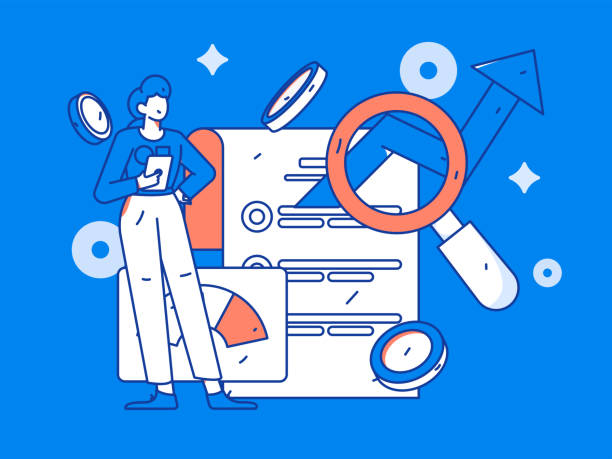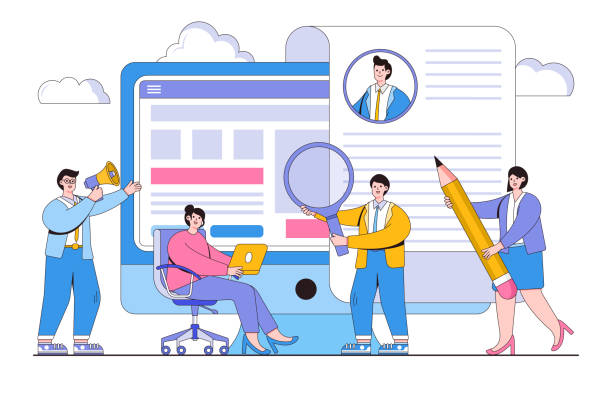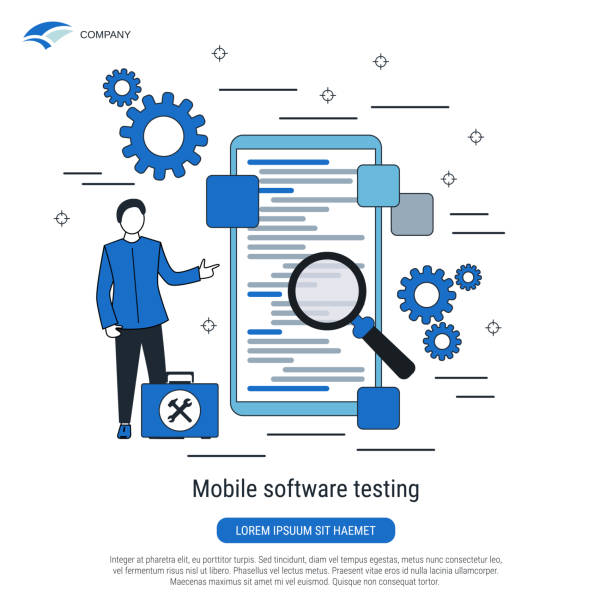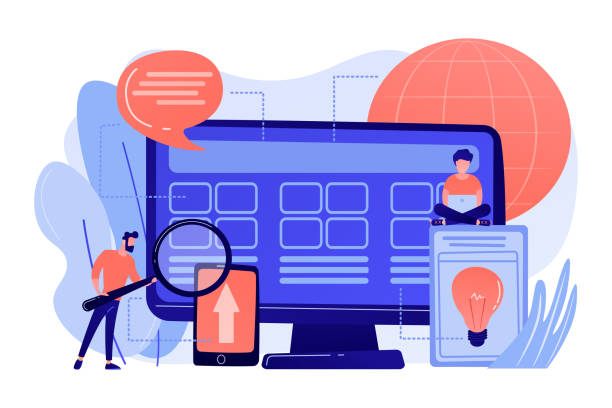The Importance of Speed in Today’s Web World

In the current digital age, speed is not only a competitive advantage but an absolute necessity for any business seeking online success.
The concept of fast website design has become more important than ever, as today’s users are more impatient than ever and expect web pages to load in a fraction of a second.
#Web_speed, #user_experience, and #SEO_optimization are three main pillars that ensure the stability and success of your website.
Have you ever thought about the impact even a one-second delay in your website’s loading time can have on your conversion rate and revenue? Studies show that many users leave a page if it doesn’t load quickly.
This is a thought-provoking topic that every business owner should deeply consider.
Providing a fast website not only means user satisfaction but also directly impacts your ranking in search engines.
Google and other search engines prioritize high-speed websites and give them a better ranking.
This article provides a comprehensive explanation of various aspects of fast website design and helps you turn your site into a launchpad.
From basic techniques to advanced methods, everything you need for website speed optimization is presented here.
This is a practical guide to achieving a high-performing website.
A slow website can quickly lead to loss of visitors and business opportunities, while a fast website brings customer trust and loyalty.
Are you losing business opportunities because of an outdated website? With Rasawweb, solve the problem of not attracting potential customers through your website forever!
✅ Attract more high-quality leads
✅ Increase brand credibility in the eyes of customers
⚡ Get free consultation for corporate website design
Fundamental Principles of Web Performance Optimization

To achieve fast website design, special attention must be paid to the fundamental principles of web performance optimization.
These principles include improving server-side code, optimizing databases, and choosing suitable hosting.
Firstly, unoptimized and heavy JavaScript and CSS codes can severely reduce page loading speed.
For example, minifying these files (Minification) and concatenating them (Concatenation) can reduce the number of requests.
This is a specialized topic that requires technical knowledge in web programming.
Secondly, database optimization also plays a crucial role; inefficient queries and large, unindexed tables can severely increase server response time.
Using database caching and periodically cleaning it of redundant data are effective steps in this regard.
Thirdly, choosing a high-quality and fast hosting is the foundation of any fast website.
Cheap shared hosting might seem tempting at first, but they often face resource limitations and slowness, making it difficult to achieve fast website design.
Virtual Private Servers (VPS) or Cloud Hosting are better options for high-traffic or growing websites.
These educational approaches help you ensure the necessary infrastructure for a high-speed website.
Also, using the HTTP/2 protocol instead of HTTP/1.1 can significantly increase loading speed, as it allows for simultaneous transmission of multiple requests.
All these steps are vital to ensuring a fast website design that provides an unparalleled user experience.
Optimizing Images and Media for High Speed

Large images and media files are often one of the main reasons for slow websites.
To achieve fast website design, optimizing these elements is essential.
This section provides a comprehensive guide to reducing image size without significant loss of quality.
First, choosing the appropriate image format is important.
For photographs, JPEG format (or WebP for better modern browser support) is usually more suitable, while for graphics and icons with transparent backgrounds, PNG or SVG are preferred.
Using newer formats like WebP can reduce file size by 25-35% compared to JPEG.
This is an important educational step.
Second, compressing images before uploading them to the server is crucial.
Numerous online tools and desktop software are available for this purpose that can significantly reduce image size.
Additionally, WordPress plugins like Smush or ShortPixel automatically optimize images upon upload.
Third, making images responsive so that their size adapts to the user’s screen dimensions is of great importance.
Using the srcset attribute in HTML allows the browser to load the best image according to the user’s device.
Lazy Loading is another effective technique that loads images out of the user’s view only when the user scrolls to them, which significantly helps with faster page loading.
These methods allow you to achieve fast website design without sacrificing visual appeal.
The table below summarizes image formats and their uses:
| Format | Primary Use | Advantages | Disadvantages |
|---|---|---|---|
| JPEG/JPG | Real photos, detailed images | Low size, wide support | No transparency support, quality loss with high compression |
| PNG | Graphics, icons, images with transparency | Transparency support, high quality without loss | Relatively high file size |
| SVG | Logos, icons, vector graphics | Infinite scalability without quality loss, low size | Not suitable for complex images or real photos |
| WebP | All image types (new) | Smaller size than JPEG/PNG with similar quality, transparency support | Limited support by older browsers |
These practical steps in fast website design are essential for any website looking to improve performance.
Caching and Content Delivery Networks (CDN)

One of the most advanced and effective methods for achieving fast website design is implementing caching mechanisms and using Content Delivery Networks (CDN).
Caching means storing a copy of your website’s content (such as HTML pages, images, CSS, and JavaScript) in the user’s browser’s temporary memory or on the server.
This means that on subsequent visits or for users who have previously loaded the content, there’s no need to reload from the main server, significantly increasing loading speed.
There are various types of caching, including Browser Cache, Page Cache, Object Cache, and Database Cache.
Proper caching implementation requires specialized knowledge in server configuration and web frameworks.
This is an explanatory content that holds great importance in optimization.
In addition to caching, Content Delivery Networks (CDN) also play a key role in accelerating website loading.
A CDN is a network of servers distributed across different geographical locations worldwide.
When a user accesses your website, the CDN delivers static content (such as images, videos, CSS, and JS) from the server closest to the user, rather than from your website’s main server.
This reduces latency and increases loading speed for users worldwide.
Companies like Cloudflare, Akamai, and Amazon CloudFront are prominent CDN providers.
Using a CDN is crucial, especially for international websites or those with high traffic volumes, ensuring a fast loading experience for all users, regardless of their geographical location.
Together, these two techniques help you achieve a fast and highly efficient website design and provide a flawless user experience.
Did you know that 94% of users’ first impressions of a business are related to its website design? With professional corporate website design by **Rasawweb**, turn this first impression into an opportunity for growth.
✅ Attract more customers and increase sales
✅ Build credibility and trust in the audience’s view⚡ Get a free website design consultation!
Speed and Responsiveness on Mobile

In today’s world, where most web traffic comes from mobile devices, fast website design and mobile responsiveness are no longer an option, but a necessity.
Mobile users expect websites to load quickly and flawlessly on their smartphones.
A website that is fast on desktop will not necessarily be fast on mobile; specific optimizations are needed for the mobile environment.
This is an analytical content that addresses mobile challenges and solutions.
The first step in this regard is ensuring Responsive Design, which allows the website to automatically adapt to different screen sizes.
This includes resizing images, fonts, and element layouts.
But responsiveness is only half the battle; mobile loading speed is even more critical than on desktop due to bandwidth limitations and device processing power.
Google’s use of AMP (Accelerated Mobile Pages) is another approach to deliver fast content on mobile, creating incredibly light and optimized versions of pages.
Optimizing CSS and JavaScript code for mobile, removing heavy and unnecessary scripts, and ensuring the use of optimized images for smaller screens all contribute to achieving fast website design on mobile.
Also, avoiding excessive redirects, using system fonts or optimized web fonts, and minimizing HTTP requests are among the factors that lead to improved user experience and mobile loading speed.
A slow mobile website can quickly discourage users and increase the Bounce Rate, while a fast mobile website provides an enjoyable user experience and helps increase engagement and conversions.
This is a comprehensive guide to improving site performance on mobile devices.
The Impact of Speed on User Experience (UX) and SEO

Website speed is not just a technical factor; it directly impacts two other vital aspects: User Experience (UX) and Search Engine Optimization (SEO).
A fast website design ensures a flawless user experience.
Today’s users are impatient, and a slow website can quickly discourage them from browsing your site.
Long loading times lead to an increased Bounce Rate, meaning users quickly leave your site.
This is not entertaining content when your business suffers from it! In contrast, a website that loads quickly encourages users to spend more time on your site, view more pages, and engage more with your content.
This, in turn, leads to an increase in conversion rates, whether it’s product purchases, form submissions, or newsletter sign-ups.
On the other hand, the connection between web speed and SEO is very strong.
Google has repeatedly stated that page loading speed is one of its ranking factors, especially after Core Web Vitals updates.
Search engines aim to provide the best experience to their users, and slow websites disrupt this experience.
Therefore, a high-speed website not only gets rewarded for improved user experience but also receives a higher SEO score, leading to better search results rankings and ultimately more traffic.
This is an important analysis that shows how fast website design is a comprehensive investment in your digital success.
Investing in website speed optimization means investing in website user experience and SEO, both of which are key factors for online success.
Website Speed Test Tools and Metrics

After implementing fast website design techniques, it is essential to regularly measure and monitor your website’s performance.
Fortunately, many powerful and free website speed test tools are available to help you identify weaknesses and implement necessary improvements.
This section is a practical guide to the most popular tools and metrics you should pay attention to.
Tools like Google PageSpeed Insights, GTmetrix, and WebPageTest are among the most commonly used.
Google PageSpeed Insights gives you a score from 0 to 100 for mobile and desktop speed and provides specific suggestions for improvement.
GTmetrix also provides a deep analysis of your website’s performance, including full loading time, page size, and the number of requests.
WebPageTest allows testing websites from different geographical locations and with various browsers, which is very useful for international websites.
These are educational tools that help you gain a deeper understanding of site performance.
Key metrics to pay attention to include: First Contentful Paint (FCP), which indicates the time it takes for the first content to appear on the screen; Largest Contentful Paint (LCP), which measures the time it takes for the largest content element to load on the screen and is an important metric for user experience; Cumulative Layout Shift (CLS), which assesses the visual stability of the page; and Time to Interactive (TTI), which indicates when the page is fully ready for user interaction.
Regular monitoring of these metrics using the above tools helps you consistently maintain a website with fast and optimized design.
The table below provides a comparison of some of these tools:
| Tool | Primary Focus | Advantages | Suitable for |
|---|---|---|---|
| Google PageSpeed Insights | Scoring and Google suggestions (Core Web Vitals) | Integration with real user data, Google-centric suggestions | All users (beginner to advanced) |
| GTmetrix | Deep performance analysis and grading | Detailed reports, Waterfall chart, loading video | Developers and SEO specialists |
| WebPageTest | Advanced testing from different parts of the world | High customization capabilities, precise technical details | Advanced developers, international tests |
Using these tools helps you continuously improve your website’s performance and achieve a fast website.
Common Mistakes in Web Design and Ways to Avoid Them

On the path to fast website design, some common mistakes can render your efforts ineffective.
Identifying and avoiding these mistakes is crucial for maintaining website speed.
This news section helps you avoid falling into the trap of these problems.
One of the biggest mistakes is overloading with scripts and plugins.
Every new plugin or script you add to your website can add to server resources and page loading time.
For example, in WordPress, excessive use of unnecessary plugins severely reduces speed.
Always ensure the necessity and quality of a plugin before installing it.
The second mistake is lack of image optimization, which was mentioned before, but its high importance necessitates re-emphasis.
High-volume images can add several megabytes to page size and severely slow down its loading.
Third, not using caching or misconfiguring it is another obstacle to achieving fast website design.
Without proper caching, the server is forced to re-process and send all content on every visit.
Fourth, poor quality hosting can also nullify all your optimization efforts.
Shared hosting with limited resources and crowded servers is not the way to a fast website.
Fifth, lack of mobile optimization, despite its growing importance, is still overlooked by some.
Non-responsive and slow websites on mobile lose a large percentage of users.
This explanatory content shows you how, by being aware of these common mistakes, you can avoid them and maintain a fast and efficient website.
A comprehensive strategy for fast website design requires attention to detail and continuous monitoring to prevent problems from arising.
How much does losing business leads due to an unprofessional website cost you? With professional corporate website design by Rasawweb, solve this problem forever!
✅ Increase credibility and trust of potential customers
✅ Easier attraction of new business leads
⚡ Get a free consultation right now!
The Future of Fast Web Design and Emerging Technologies

The web world is rapidly evolving, and with it, new technologies and approaches for achieving fast website design are emerging.
A look into the future shows that focus on speed and efficiency will remain a top priority.
This analytical section examines some emerging technologies that will revolutionize the landscape of web design.
One of these technologies is Progressive Web Apps (PWAs).
PWAs offer a combination of the best features of web and native applications.
They can load quickly, even work offline, and provide a user experience similar to native apps, directly contributing to fast website design.
This is important news for developers.
Another is Serverless Computing, which allows developers to run backend code without the need to manage servers.
This can lead to reduced costs and increased response speed for specific website functionalities.
Edge Computing, which involves processing data closer to its source (at the edge of the network) instead of sending it to a central server, can minimize latency and increase content loading speed, especially for users far from main servers.
Furthermore, advancements in web standards and protocols like HTTP/3, built on UDP and promising higher speeds, will significantly contribute to faster website loading.
Artificial intelligence and machine learning can also play a role in the future for automated website optimization, including identifying traffic patterns and pre-loading content.
All these innovations are moving towards creating an instant and seamless user experience and will play a key role in the fast website design of the future.
Readiness to adopt these technologies enables businesses to stay at the forefront of competition.
Conclusion and Practical Steps for a High-Speed Website

In this comprehensive article, we explored various aspects of fast website design, detailing its importance for user experience and SEO, advanced optimization techniques, and the future of this field.
It’s clear that website speed is no longer a luxury feature, but a foundation for the success of any online business.
To summarize and provide practical guidance, here are the key steps to achieving a high-speed website: First, measure your current site’s speed.
Use tools like Google PageSpeed Insights and GTmetrix to identify weaknesses.
Second, optimize your images and media files.
Use appropriate formats, compress them, and implement Lazy Loading.
Third, enable caching and CDN.
These two techniques significantly reduce loading time.
Fourth, optimize your website’s code.
Minify CSS and JavaScript and avoid redundant code.
Fifth, choose suitable and high-speed hosting.
Poor hosting can nullify all your efforts.
Sixth, optimize your design for mobile and ensure full responsiveness.
These steps provide a practical framework for fast website design.
Remember that speed optimization is an ongoing process.
Technologies change, your site’s content grows, and user expectations rise.
Therefore, regular monitoring and applying necessary updates are crucial for maintaining your website’s high speed.
By implementing these recommendations, you will not only provide a better user experience but also improve your SEO ranking and, ultimately, significantly contribute to the growth of your online business.
The future belongs to fast and efficient websites; take action for your fast website today.
Frequently Asked Questions
| Question | Answer |
|---|---|
| What is fast website design? | The process of building a website that loads quickly and provides a smooth user experience. |
| Why is website speed important? | Improved user experience, reduced bounce rate, increased conversion rate, and better search engine ranking (SEO). |
| What factors affect website speed? | Image size, number of HTTP requests, code optimization (HTML, CSS, JS), host speed, and browser cache. |
| How can website speed be improved? | Optimizing images, compressing files, using caching, choosing suitable hosting, and reducing unnecessary plugins. |
| How do images affect website speed? | Large or improperly formatted images can significantly increase page loading time. |
| What is the role of JavaScript and CSS in website speed? | Unoptimized code, high volume, or blocking execution can reduce page rendering speed. |
| How much does hosting affect website speed? | The speed and quality of the hosting server directly affect website response time and initial loading speed. |
| What tools are available to check website speed? | Google PageSpeed Insights, GTmetrix, Pingdom Tools are common tools. |
| What are the benefits of a fast website? | Greater user satisfaction, reduced bounce rate, increased time on site, and improved ranking in Google results (SEO). |
| What are common mistakes that slow down a website? | Using unoptimized images, bulky and unorganized coding, excessive use of plugins, and not using caching. |
And other services of Rasa Web Advertising Agency in the field of advertising
Smart Social Media: A professional solution for digital branding focusing on optimizing key pages.
Smart Conversion Rate Optimization: A creative platform to improve website traffic increase by customizing user experience.
Smart Conversion Rate Optimization: A creative platform to improve sales increase with intelligent data analysis.
Smart Custom Software: A combination of creativity and technology for analyzing customer behavior by using real data.
Smart Custom Software: Revolutionize digital branding with the help of custom programming.
And over hundreds of other services in the field of internet advertising, advertising consulting, and organizational solutions
Internet Advertising | Advertising Strategy | Advertorial
Resources
What is Page Speed and How to Increase It? – Websima
Website Optimization: SEO Training | Best Website SEO Methods – Novin
How to Increase WordPress Site Loading Speed? (8 Top Methods) – MihanWP
How to Increase Website Speed? Introducing Tools and Methods – 7Learn
? To shine in the digital world and reach the pinnacle of success, Rasawweb Afarin Digital Marketing Agency, by providing comprehensive services including professional website design and SEO, is with you to elevate your business to the position it deserves.
📍 Tehran, Mirdamad Street, next to Bank Markazi, Southern Kazeroon Alley, Ramin Alley, No. 6




